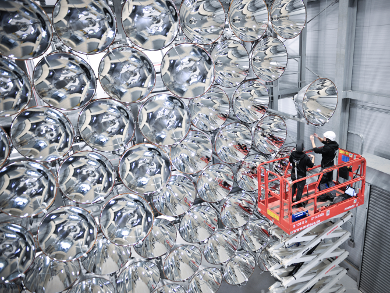As it burns without producing CO2, hydrogen is considered to be the fuel of the future. Significant amounts of energy are needed to produce hydrogen by splitting water into hydrogen and oxygen. In future, this might be obtained from the Sun. Fuels, propellants, and combustibles acquired using solar power offer great potential for long-term storage, the production of chemical raw materials, and the reduction of CO2 emissions. Sunlight in central Europe is unreliable and irregular, so an artificial Sun is the preferred choice for developing production processes for solar fuels.
The DLR Institute of Solar Research has implemented the research facility Synlight. In this three-storey building, there are 149 Xenon short-arc lamps. For comparison: The screen in a large cinema is illuminated only with a single Xenon short-arc lamp. The ‘radiators’ can be focused on an area of 20 by 20 cm. With Synlight’s 350-kW array, this results in 10,000 times the intensity of the solar radiation at the surface of the Earth. Temperatures at the target point of the lamps can reach up to 3,000 °C. Researchers want to use these temperatures to manufacture fuels, including hydrogen. Three radiation chambers are available for experiments.
Synlight was constructed by the Jülich Research Centre over the last two years. It costs 3.5 million euro. The state of North-Rhine Westphalia, Germany, supported the project with 2.4 million euro. The difference of 1.1 million euro was provided by the German Federal Ministry for Economic Affairs and Energy (BMWi).
- Institute of Solar Research, German Aerospace Center (Deutsches Zentrum für Luft- und Raumfahrt; DLR), Germany
- Jülich Research Centre (Forschungszentrum Jülich; FZJ), Jülich, Germany
